A popular guiding solution is the 50mm guide scope, often by converting an existing 9×50 finder scope. It has the advantage that it is light, it can fit on your existing finder shoe, it is very fast giving you many stars at low exposures and it can be quite effective at short and medium focal lengths. After getting a bit frustrated with a couple of OAGs (off-axis guiders), I looked into adapters for converting the classing 9×50 finder, however they were very expensive for what they are, and, as I found out, for a little more you can get a dedicated guide-scope that should be better suited to the task. I got two units sold by “Solomark”. Well, I got one unit actually, it was very competitively priced, came quickly, but it was the wrong one! It was obviously an honest mistake as I received a more expensive unit, but I had not read good things about guiding with helical focusers, hence I wrote them and they immediately sent me the one I ordered and told me to keep the more expensive one, so that was some great service from Solomark. But, you will also find these guide-scopes sold under various names, sometimes with minor differences and for varying prices. Let’s have a look at them:
Solomark 50mm Mini Guide Scope
 If it seems familiar, that’s because it is identical to the Orion 50mm mini guider (including all the accessories that come with the Orion). In fact, my unit came marked as “Starguider”, which is how Agena brands their own version, and there is also a TS (Teleskop-Service) version. The optics look good and construction is metal except the 3 adjustment screws, but relatively light at 496g including the stand which fits snuggly on the usual skywatcher/celestron etc finder-scope shoe (a shoe is also included if don’t have one).
If it seems familiar, that’s because it is identical to the Orion 50mm mini guider (including all the accessories that come with the Orion). In fact, my unit came marked as “Starguider”, which is how Agena brands their own version, and there is also a TS (Teleskop-Service) version. The optics look good and construction is metal except the 3 adjustment screws, but relatively light at 496g including the stand which fits snuggly on the usual skywatcher/celestron etc finder-scope shoe (a shoe is also included if don’t have one).
Focusing is a bit awkward: you focus roughly by manually sliding your camera into the tube as much as required and tightening (you can attach the provided parfocal ring to not have to repeat this) and then you can adjust a bit by rotating the front part which can move the objective by a few mm. Due to this limited focus travel, to focus with an eyepiece (i.e. to use this as a regular finderscope) you need a small extension. I also tried a 1.25″ diagonal, but that added too much distance so I could not get focus with an eyepiece, so you are quite limited if you expected to swap the camera with an eyepiece now and then.
I don’t see a way to remove the guide scope from the holding bracket (in case you wanted to upgrade the bracket or the scope) and the 3 adjustment screws provide very little travel, although I doubt you’d have a problem finding a guide star with a decent guide camera.
The specs claim 162mm f/3.2, however plate-solving with a QHY5L-IIm camera gave me 183mm. This is actually a bit more useful, as at f/3.66 it is still really fast, but the extra focal length is welcome.
Where to buy: Right now I see the Solomark out of stock, but you can get the Orion version at a decent price from Amazon.com or Amazon.co.uk. There is also the StarGuider version on ebay.com.
Solomark F50 Guidescope
Right from the start, I liked the smooth, graded helical focuser that makes focusing very easy, a big advantage over models without one. In fact, apart from the helical focusing travel, the focuser has a telescoping drawtube (also graded) which allows you to reach focus easily even with an eyepiece – no need for an extension. Some people claim helical focusers can add flexure, so we’ll have to see about that. The optics look good (real 50mmm unobstructed aperture) and the build is solid, even the front cap is metal (no focuser cap though, strangely), except the nylon screws – although it seems quite sturdy I have heard some cases where nylon screws added flexure, so that’s an additional concern. The total weight of base & optical assembly is 590g.
Now there is a small issue with the dovetail. While you’d expect it to be the same size as the usual finderscope base, it is, in fact, a few mm thinner. This has the effect that some bases with relatively short screws (e.g. the standard finder shoe on the SkyWatcher Evostar 80ED) can’t reach it to secure it. A longer screw fixes the problem (and some shoes, like the one on my SkyWatcher 130PDS, don’t have an issue to begin with).
The specs claim “190mm f/3.4” (which does not exactly compute with a 50mm aperture), and plate-solving with a QHY5L-IIm camera gave me a close enough value of 182mm focal length, which makes it a very fast f3.64. There is also an “F60” model, which is the 60mm version.
Where to buy: You can get the F50 on Amazon.com or Amazon.co.uk. You can get cheaper unbranded versions from China on Ebay, although I can’t vouch for any specific seller. You might be tempted to also look at the larger F60 at Amazon.com or Amazon.co.uk, although I haven’t tried it myself.
Specs summary:
| Model | Aperture (mm) | Claimed FL (mm) | Measured FL (mm) | f-ratio | Weight | Price |
|---|---|---|---|---|---|---|
| 50mm Mini Guide Scope | 50 | 162 | 183 | 3.66 | 496g | $89–$103 / £79 |
| F50 Guidescope | 50 | 190 | 182 | 3.64 | 590g | $110 / £89 |
Using the Guide Scopes
I tried both with a 20mm eyepiece and they performed similar to a classic 9×50 finder, while I didn’t do a very careful comparison, there was no excessive CA or anything distracting like that, so you should expect to use them as a finder as well if you like. As I explained though, the Mini guide scope has some trouble achieving focus with an eyepiece, so if you swap out the camera you need an extension plus eyepiece. The F50 with its helical focuser and telescoping drawtube has a range that can accommodate cameras and eyepieces. More importantly, it takes a few seconds to find exact focus and there are screws to lock it. With the Mini Guide scope focus is rather cumbersome. Theoretically, you slide your camera (or eyepiece) in/out and you lock it at a rough focus, then use the objective ring to achieve fine focus. As the objective ring is much less smooth than a helical focuser and changes focus very slowly, it does take some effort. That’s why you are given a parfocal ring, hopefully you can fit it on your camera and not have to focus it again. I can see how it would not be that much of a problem if it gave me more stability (i.e. was less prone to flexure), and the apparent popularity of the Mini Guide Scope (at least the Orion version) seem to indicate that many users don’t really mind.
On to actual guiding. Both these Guide Scopes are around f/3.6. With modern sensitive guide cams, this means that wherever you point your scope there are always bright enough stars for guiding, without any additional effort. In fact, with my QHY5L-II mono, I usually had at least one star bright enough to work with a 0.1s exposure and very seldom has it seemed marginal enough to warrant 0.2s. If you are planning to use something like a webcam though, you might appreciate the fact that the F50 gives you a lot of movement via its nylon screws, so you can change the aim of the guide-scope as you wish. The nylon screws don’t seem particularly stiff which was a worry for me initially, but I did try to screw them very tightly to avoid any possible flexure as much as I could.
In any case, I had absolutely no trouble setting up a guiding session with Phd2 for 5 minute exposures with my iOptron ZEQ25. Guiding was with a QHY5L-II mono (3.75μm pixel size) and imaging with a Canon 600D mod (4.3μm pixel size). Let’s have a look at the results.
Guiding Results
I first tried my SkyWatcher Equinox 80ED with the 0.8x TRF-2008, giving an effective focal length of about 400mm. Both guiders gave perfect and indistinguishable results at 5 minute exposures of the Crescent Nebula and M33, using my . Here are some 100% size crops:
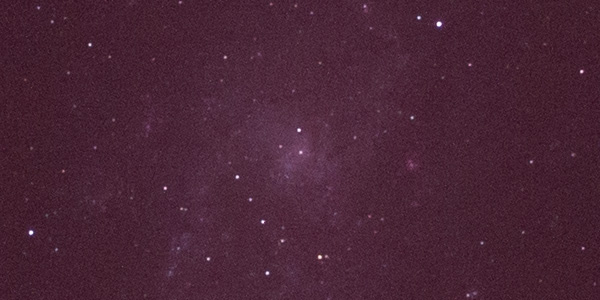
5min 100% crop M33 with F50 Guidescope
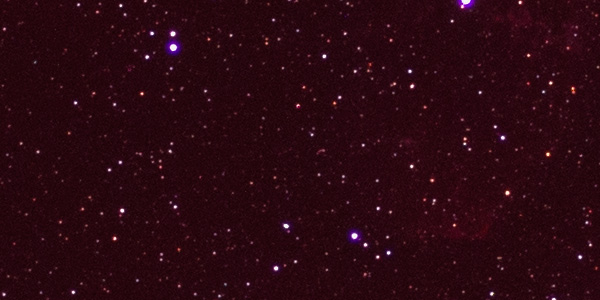
5min 100% crop Crescent nebula with Mini Guide Scope
If you are interested in how the fully stacked and processed image of the Crescent nebula came out, here it is (click to enlarge):
Next, I tried a few exposures of M33 with the Evostar 80ED (600mm FL), again I could not distinguish between the two guide scopes, which I guess is a good thing:

5min 100% crop M33 with Evostar 80ED and F50 guide scope
So, at least at these focal lengths, the nylon screws and convenient helical focuser of the F50 guide scope don’t seem to give it a disadvantage in regards to flexure.
Moving on, what about larger focal lengths? Some sellers claim that a 50mm guide scope is good for up to about 1000mm, some claim up to 1500mm. I guess it sort of depends on the relative pixel sizes of your imager as well, with very big pixels, even a longer focal length is not very demanding. I thought I’d try an extreme example, i.e. my C9.25 without a focal reducer, still with the Canon 600D which does not have large pixels, so requires decent guiding. We are talking about 2300 mm focal length here, so let’s see an example exposure at 2 minutes:

F50 guide scope, 2min Blue Snowball /w C9.25 @ f/10
Now, the issue is that my C9.25 is quite under-mounted (I originally got it with the intention of only doing planetary on the tiny ZEQ25 mount), so there is some vibration etc with the C9.25 which does not give me tiny stars (especially without a reducer/corrector), hence the above image I’d say is typical of what the C9.25 & ZEQ25 can do (and that is if there is no significant wind!), so at least the F50 did not seem to add anything bad to the equation, and again it was not different from the theoretically less flexure-prone Mini guide scope. If you are curious about how the blue snowball came out at 29x2min, here it is:
For 5 minute exposures with the C9.25, I gave a try at the 0.63x reducer – according to plate-solving this brings my setup to 1420mm focal length. Of course it adds more weight to my already way heavy equipment, but the results are not bad, as this 100% crop of a 7x5min stack of the cocoon nebula shows:
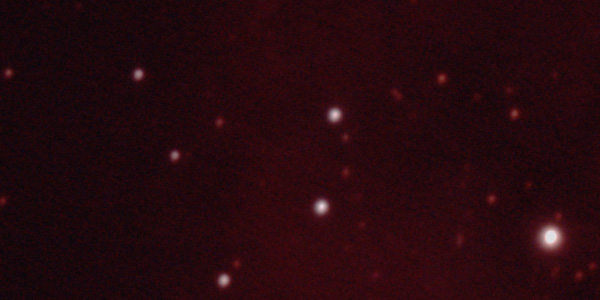
I would need a heavier mount to actually answer the question of whether a 50mm guide scope can REALLY do 1500mm, or the more modest 1000mm claim is more realistic (perhaps when I go to my summer house where my HEQ5 awaits), but I think I am confident that the helical focuser and the nylon screws don’t add any detectable flexure to the system and, in fact, even on a tiny ZEQ25 you can guide a 9.25 inch SCT with at least some success, especially if you combine the results with a shorter focal length to add detail to the core of DSO objects like this:
I did the same with M33, a hard target for my light-polluted back yard:
Not bad results IMHO.
Conclusions
You might have noticed that most of the images above are using the F50 helical focuser guide scope. Indeed at some point I stopped trying to compare them and started using the F50 exclusively, since it only had advantages. Mainly, it allowed me to quickly change between an eyepiece and a guide camera, which was useful when switching OTAs. There were no problems (e.g. flexure) that I could detect with either guide scope, especially at 600mm or lower focal lengths which are the most common usage cases for such guide scopes.
I can see why some sellers or manufacturers might claim they are good for up to 1500mm, as I did end up using them at such focal lengths with my test setup, but it was a setup not intended for imaging at such focal lengths, so the exact precision of the guiding at 1500mm cannot be evaluated. Realistically, if you are serious about guiding at over 1000-1500mm and you don’t have huge pixels on your imager, I suggest you go for a guide scope at around 250-400mm to be safe. However, with OTAs up to around 1000mm, these 50mm guiders are recommended, as they are much easier to setup than having to deal with the protruding prisms and guide star-finding issues of OAGs, and it doesn’t seem to me that you have to spend more for some branded versions that have much higher prices.

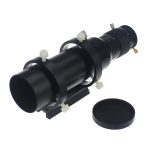



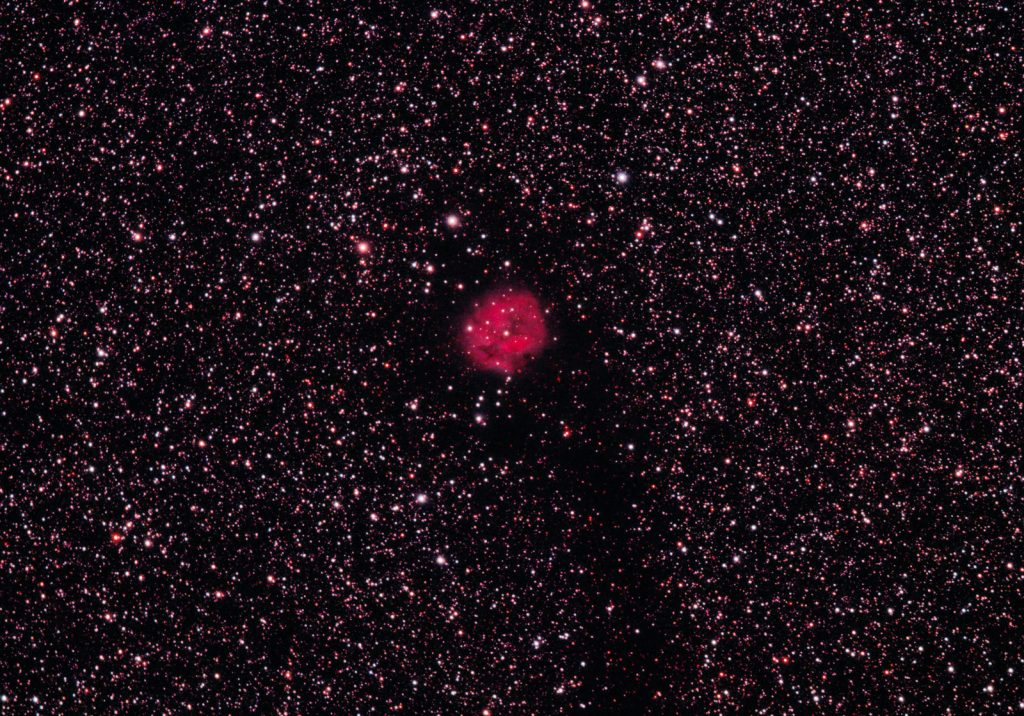

Hello! My Google searches have ultimately brought me to your page 🙂
Long story short: I want to purchase a clone of the ‘Solomark F50 Guidescope’ you described above (the ‘Datyson 50mm Guide Scope’) and I want to attach it to a side-by-side dovetail base, along with (for example) a DSLR. I am confused by the different types of dovetail mounts that are used by astronomical equipment. Typical ‘finderscope’ ones seem be 24mm top/36mm bottom widths (is the Solomark F50 like this?) but the dovetail bar at the bottom of my Celestron C90 uses the Vixen (?) 36mm top/44mm bottom widths.
The store ‘Astroshop’ on AliExpress has 3 different models of side-by-side dovetail plates, each with a different type/combination of dovetail clamps — with no measurements to tell me what they are 🙁
Thanks for any advise and info you can provide!
Sorry, I was on vacation. In case you haven’t figured it out, you are right, the telescope dovetails (the Vixen is the smallest and most common in small scopes/mounts) are indeed larger than the finderscope dovetails and the usual dual saddles you will find are for those. The F50 is 30mm at the widest point (bottom), so it cannot go into such a saddle directly. However, the dovetail of the finderscope unscrews from the rings so theoretically you could screw it to an appropriate vixen dovetail. That seems to be the best solution to your problem. Of course, you still need to make sure the side by side saddle you buy accepts vixen and not something else!
Great review and write up. Best on the topic I could find regarding those scopes.
Glad you liked it.